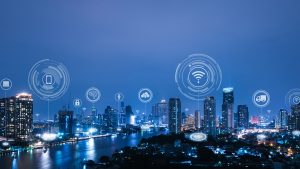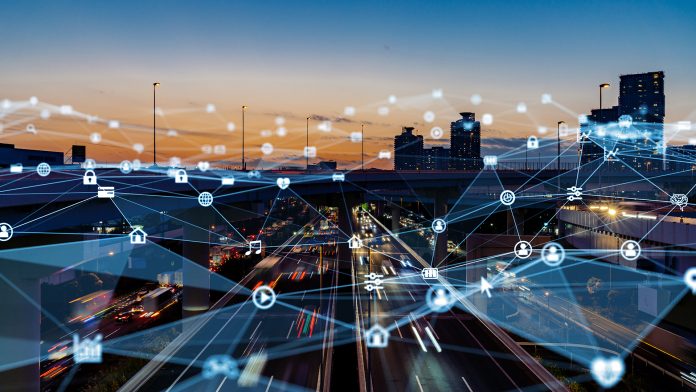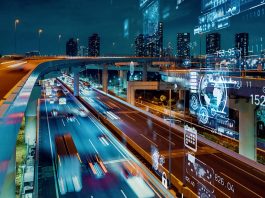Chris Bishop, Marketing Director APAC at Ipsotek, an Eviden business, explains how combining evolving technologies such as 5G networks, IoT, and AI impacts business operations.
The breadth of opportunities presented by the increasingly frequent availability of 5G networks spans multiple sectors and industries, arguably none more so than across transportation. From providing a smooth and hassle-free experience for passengers to enhanced capabilities in order to respond to critical safety incidents in real-time, the scope of 5G use cases at transportation hubs is seemingly endless.
Consider, for example, the growing pressure transportation authorities face with compliance with ever-evolving safety protocols. This has made disciplines such as crowd management and people counting at transportation hubs more important than ever before.
Step in 5G networks, which as an enabler for ubiquitous AI-driven video analytics, means that processing CCTV camera streams at the edge across a large network has become much easier.
Utilising AI video analytics
Leveraging the power of edge-based AI analytics allows organisations to take advantage of existing infrastructure to enhance their operational capabilities. When combined with edge-based AI, CCTV can provide valuable insights to enhance safety, security, reliability, and efficiency across an organisation’s operations.
Furthermore, the metadata compiled from edge-based AI solutions can be accessed and viewed in real-time via dynamic dashboards to provide operators with the real-time status of their designated KPIs This provides transport operators with a wealth of information to help them better manage the infrastructure and networks within their hubs, be that an airport, railway station or port.
In the case of a railway station, for example, using CCTV and edge-based AI video analytics to monitor tracks, tunnels, and the wider station infrastructure can significantly reduce incident response times. Sydney Trains is one such operator that has embraced this technology to automatically process video to identify tunnel and track intrusion incidences at 13 stations across the metropolitan Sydney area, resulting in significant reductions in major disruptions to passenger journeys.
Other key use cases applicable at all types of transportation hubs include identifying passengers moving in different directions to crowds, loitering in private/restricted areas, and detecting abandoned objects. Quickly detecting such incidents and raising alerts could prevent incidents from escalating and potentially save lives.
A smooth and efficient passenger experience
The benefits achievable from integrating edge-based AI and 5G networks extend beyond the transportation industry’s security and health & safety benefits. Indeed, the potential for contactless travel can be increased via 5G to enable a quicker, more convenient, frictionless travel experience for passengers.
In the longer term, we will very likely see the use of 5G-enabled autonomous vehicles at travel hubs, and it’s not wildly unrealistic to imagine a scenario whereby airport passengers simply scan a smartphone to access car parking facilities and pass through security using biometric ID.
Another positive benefit for passengers is less time waiting around and more time enjoying other airport or railway station activities, such as shopping and dining. This provides an opportunity for retailers to tailor mobile apps and offer more personalised customer experiences for passengers.
An additional use case for 5G networks and edge-based AI video analytics is for cargo handling at airports, ports, and railway stations. The efficiency of such operations could be significantly improved using handheld or IoT readers for scanning barcodes, with the data collected transferred via a 5G-enabled network to a central location that is accessible to service providers and logistics partners. Being able to connect and gather data from IoT devices by reading barcodes on freight containers would enhance the efficiency of the loading and unloading process.
The smart case for IoT
As town planners, governments and councils increasingly turn towards technology solutions to support the future development of smart cities, IoT is also being widely utilised in these environments. In addition to its benefits for smart city planning (e.g. operating as sensors to collect data such as air quality), IoT has a critical role to play in interpreting the data it gathers.
Indeed, the amount of data generated by IoT devices is forecast to reach 79.4 ZB by 2025, according to IDC. However, this data is only insightful and valuable from a smart city perspective if the capability exists to adequately analyse it. This is where data analytics comes to the fore, with IoT and data analytics coexisting within a smart city framework across areas such as:
Traffic
Using sensors to track and deliver updates in real time about traffic flow to a central management platform, IoT can help town planners identify traffic patterns. Internal systems can then be used to autonomously adjust the sequence of traffic lights, for example.
Air quality and waste
Smart cities are increasingly deploying new technologies to monitor pollution levels, including collecting data on the volume of dust and air particles. IoT systems can help with this via smart sensors to send an alert when rubbish bins are close to capacity, thereby ensuring that collections are made when needed.

Smart infrastructure
Automated lighting and smart lifts utilise IoT sensors that share data with each other to help connected buildings and homes continuously learn from their environment and ultimately reduce power usage. Storm drains fitted with IoT sensors broadcast the depth and rate of flow of water during storms, which in turn are broadcast to residents.
Changing attitudes to AI
Depending on what you read, the court of public opinion regarding AI is perhaps still somewhat divided, despite the multiple use cases identified above. A survey published by Ipsos Mori, for example, highlights a mixed outlook.
The research examined public attitudes to AI across 28 countries, identifying that opinions on the technology and its capabilities were intrinsically linked to a country’s economic development and prosperity level.
Specifically, respondents from emerging nations were significantly more likely to have a positive outlook on AI. Familiarity appears to be the key to this, with respondents in emerging economies more familiar with AI tools and solutions than their counterparts in developed economies.
Familiarity with AI is best increased through education and training, which in turn will likely improve trustworthiness too. Throughout the COVID-19 pandemic, we saw how AI came to the fore to support businesses and individuals in a myriad of ways, from contact tracing and social distancing to workflow automation and predictive analytics.
Whether AI, 5G networks, IoT or any combination of these in tandem, it has never been clearer how much new technologies impact multiple aspects of everyday life and business.
The trajectory is only going one way. By embracing that fact and continuing to evolve the use cases for such technologies, society will truly realise the benefits.








